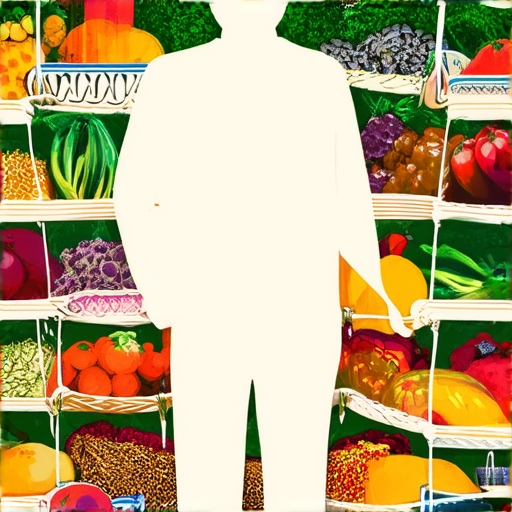Thriving on a limited budget requires careful planning and strategic decision-making when it comes to grocery shopping. With the right approach, it’s entirely possible to live off top budget-friendly items, even with a monthly food budget of just $100. In this comprehensive guide, we’ll explore the most affordable food options, share expert tips on creating a monthly grocery list on a shoestring budget, and provide valuable insights into maximizing your grocery budget with smart shopping habits.

Living Off $100 a Month for Food
I’ve been living off $100 a month for food, and I’m excited to share my tips and tricks with you.
- Plan Your Meals: Before you start grocery shopping, plan out your meals for the week. This will help you avoid buying unnecessary items and reduce food waste.
- Cook in Bulk: Cooking large batches of food can save you money and time during the week. Consider making soups, stews, or casseroles that can be reheated throughout the day.
- Shop Smart: Visit local farmers markets or discount grocery stores to find affordable produce and staples. Consider buying in bulk and freezing items like fruits and vegetables.
- Use Coupons and Discounts: Take advantage of digital coupons, cashback apps, and loyalty programs to save even more on your groceries.
- Stretch Your Dollars: Get creative with leftovers and use them to make new meals. Consider making your own bread, pasta sauce, or granola to save money and reduce packaging waste.
Some of My Favorite Resources Include:
- Amazon – for online grocery shopping and competitive pricing
- Walmart – for affordable prices on staples and household items
- Macy’s – for discounted clothing and household items
- Farmers Market – for fresh, locally-sourced produce
Tips for Eating Healthy on a Budget:
- Eat seasonal produce to take advantage of lower prices
- Buy in bulk and freeze items like beans, grains, and nuts
- Make your own snacks, like trail mix or energy balls
- Use herbs and spices to add flavor instead of relying on expensive sauces and condiments
- Drink water instead of sugary drinks to save money and stay hydrated
Spending $20 a Week on Groceries
I’m always looking for ways to save money on my weekly grocery bill, and I’ve found that planning ahead and making smart choices can really make a difference.
- Plan Your Meals: Before you go shopping, take some time to plan out your meals for the week. This will help you avoid buying unnecessary items and reduce food waste.
- Make a Grocery List: Once you have your meal plan, make a list of the ingredients you need to buy. Stick to your list when you’re at the store to avoid impulse purchases.
- Shop Sales: Check the weekly ads for your local grocery stores and plan your shopping trip around the items that are on sale. Stock up on non-perishable items when they’re at their cheapest.
- Buy in Bulk: Purchasing items like rice, pasta, and canned goods in bulk can save you money in the long run. Just be sure to store them properly to maintain their freshness.
- Shop at Discount Stores: Consider shopping at discount stores or dollar stores for non-perishable items like canned goods, cleaning supplies, and personal care items.
- Use Cashback Apps: Cashback apps like Ibotta and Fetch Rewards offer cashback on certain grocery items. While the savings may not be huge, every little bit counts!
- Shop in Season: Produce that’s in season is often cheaper than out-of-season produce. Plus, it tastes better and is better for the environment!
- Use Unit Prices: When comparing prices between different brands or sizes of an item, check the unit price (price per ounce or pound) to make sure you’re getting the best deal.
- Don’t Shop When You’re Hungry: Shopping for groceries on a full stomach can help you avoid impulse purchases and stick to your list.
- Use Store Loyalty Programs: Many grocery stores offer loyalty programs that can help you save money on gas, groceries, and other items.
By following these tips, I’m able to stay within my $20 weekly grocery budget and still eat healthy, delicious meals. Happy shopping!

The Cheapest Food to Stock Up On
I’m always looking for ways to save money on groceries, and stocking up on affordable staples can make a big difference.
- Rice is often one of the cheapest grains available, with a 20-pound bag costing around $15-$20.
- Canned beans, such as black beans, kidney beans, and chickpeas, are another great option, with prices ranging from $1-$3 per can.
- Oats are a versatile and affordable grain that can be used for oatmeal, baking, or as a hot cereal, with a 4-pound bag costing around $5-$7.
- Pasta is a staple in many households, and a 12-pound box can cost between $10-$15.
- Granola is a tasty and filling snack that can be made at home with rolled oats, nuts, and seeds, with a 4-pound bag costing around $10-$12.
- Eggs are an excellent source of protein and can be purchased in bulk, with a dozen eggs costing around $1.50-$2.50.
- Quinoa is a nutritious and filling grain that can be used in salads, stir-fries, or as a side dish, with a 2-pound bag costing around $5-$7.
- Canned tuna is a convenient and affordable protein source, with prices ranging from $2-$5 per can.
- Brown rice is another affordable grain option, with a 20-pound bag costing around $20-$25.
- Canned tomatoes are a staple in many recipes, with prices ranging from $1-$3 per can.
- Almonds are a nutritious and filling snack that can be purchased in bulk, with a 12-ounce bag costing around $10-$12.
- Whole wheat flour is a versatile ingredient that can be used for baking, making pasta, or as a thickening agent, with a 5-pound bag costing around $10-$12.
When shopping for these items, consider buying in bulk and storing them properly to maximize shelf life and savings.
Some popular stores for buying these items in bulk include Costco, Sam’s Club, and Aldi.
Additionally, consider shopping during sales tax holidays or using cashback apps like Ibotta or Fetch Rewards to earn rewards on your purchases.
By stocking up on these affordable staples, you can save money and have a steady supply of nutritious food for months to come.

The Cheapest Meal You Can Live By
I’ve been living on a tight budget for years, and I’ve learned that eating cheap doesn’t have to mean sacrificing flavor or nutrition.
- Beans: Dried beans are the cheapest option, but canned beans are a great timesaver. Black beans, chickpeas, pinto beans, and lentils are very versatile and can be used in a variety of dishes.
- Pasta: A classic and inexpensive base for many quick dishes, pasta is a staple in my pantry. I like to pair it with marinara sauce and vegetables for a healthy and filling meal.
- Eggs: Eggs are a fantastic source of protein that’s affordable and works for breakfast, lunch, or dinner. Scrambled eggs with toast or hash browns make for a satisfying meal.
- Oats: Oats are another cheap and nutritious option that can be used for oatmeal, overnight oats, or even as a thickening agent in soups and stews.
- Canned Goods: Canned tuna, chicken, and beans are all affordable and can be used in a variety of dishes. Look for sales and stock up when you can.
- Grains: Brown rice, quinoa, and whole wheat bread are all cheap and nutritious options that can be used in a variety of dishes.
When it comes to cooking on a budget, it’s all about planning ahead and using what you already have on hand. Here are some tips for cooking cheap:
- Plan Your Meals: Take some time each week to plan out your meals for the next few days. This will help you avoid last-minute takeout or fast food runs.
- Make a Grocery List: Once you have your meal plan, make a grocery list of the ingredients you need. Stick to the list when you’re at the store to avoid impulse buys.
- Shop Sales: Check the weekly ads for your local grocery stores and plan your shopping trip around the items that are on sale.
- Use Coupons: Clip coupons from the Sunday paper or look for digital coupons on store websites and apps.
- Buy in Bulk: Purchasing items like rice, pasta, and canned goods in bulk can save you money in the long run.
By following these tips and incorporating some of the cheap and nutritious foods listed above into your diet, you can eat well without breaking the bank.
Additional Resources:
If you’re looking for more ideas on how to cook cheap, check out the following resources:
Living on 50 a Week for Food
I set my grocery budget to 50 for the week, and I was determined to make it work.
-
First, I planned out my meals for the week, making sure to use all of the ingredients, both raw and cooked, plus pantry staples and frozen goods.
-
This approach allowed me to make a week’s worth of dinners for around 50 in groceries.
-
To stretch my budget further, I focused on buying in bulk and purchasing items that were on sale.
-
I also made sure to shop at discount stores and dollar stores for non-perishable items.
-
Another strategy I employed was meal planning around what was already in my pantry and fridge.
-
This helped reduce food waste and ensured that I wasn’t duplicating purchases.
-
In addition to these tactics, I also tried to cook meals that served multiple purposes, such as soups that could be eaten for lunch or dinner.
-
By implementing these strategies, I was able to successfully live on 50 a week for food.
Key Takeaways:
-
Plan your meals in advance to ensure you’re using all of your ingredients.
-
Bulk up on non-perishable items and purchase items on sale.
-
Shop at discount stores and dollar stores for non-perishable items.
-
Meal plan around what’s already in your pantry and fridge to reduce waste.
-
Cook meals that serve multiple purposes to maximize efficiency.
Additional Tips:
-
Consider shopping at local farmers markets or joining a community-supported agriculture program for fresh produce.
-
Look for coupons and discounts online or sign up for rewards programs to save even more.
-
Get creative with leftovers and find ways to repurpose them into new meals.

What Do Low-Income Families Eat?
Low-income families often struggle to afford healthy food options due to financial constraints.
- Cereals, pasta, potatoes, legumes, and fatty meats are common staples in low-income households.
- Vegetables and fruits are often limited to iceberg lettuce, potatoes, canned corn, bananas, and frozen orange juice.
Dietary Challenges Faced by Low-Income Families
- Limited access to grocery stores and supermarkets selling fresh produce.
- Higher prices for organic and specialty foods.
- Inadequate cooking facilities and utensils.
- Lack of nutrition knowledge and meal planning skills.
Strategies for Improving Food Security
- Participate in local food assistance programs, such as SNAP (Supplemental Nutrition Assistance Program).
- Visit community gardens and participate in urban agriculture initiatives.
- Shop at discount grocery stores and dollar stores.
- Prepare meals in advance and cook in bulk.
Nutrition Education and Resources
- Consult with registered dietitians and nutritionists for personalized advice.
- Access online resources, such as USDA’s MyPlate and ChooseMyPlate websites.
- Join local health organizations and advocacy groups focused on food security.
Conclusion
Low-income families face significant challenges in accessing nutritious food options. By understanding these challenges and implementing strategies for improving food security, individuals can work towards achieving better health outcomes and reducing the burden of food insecurity.
